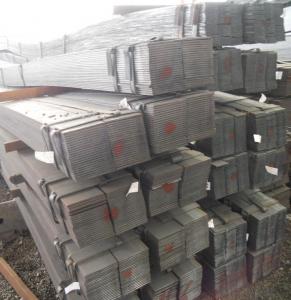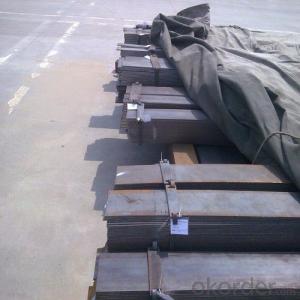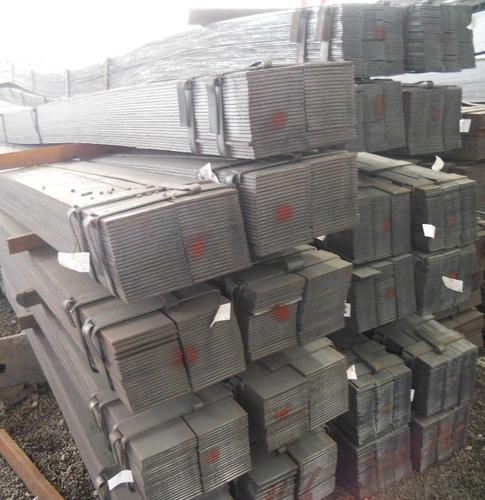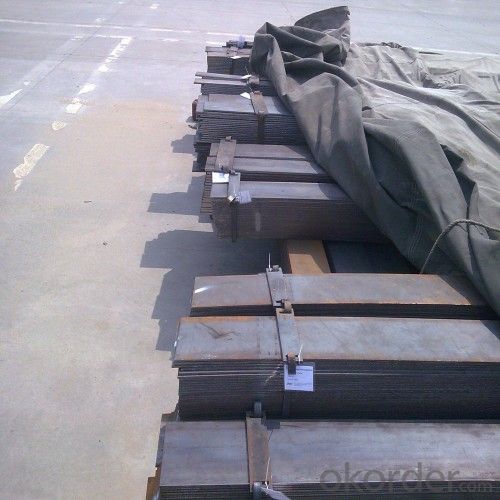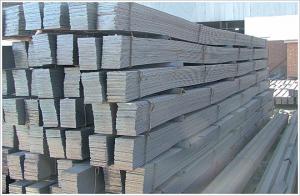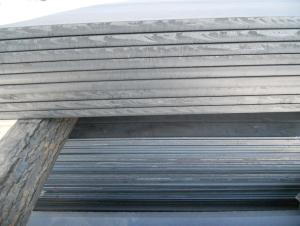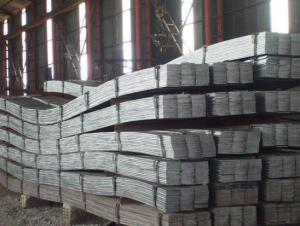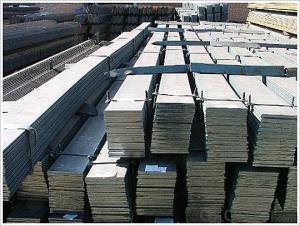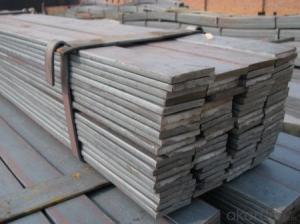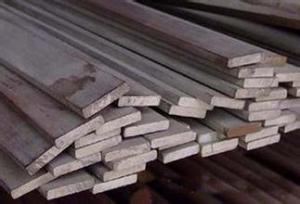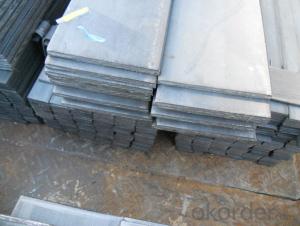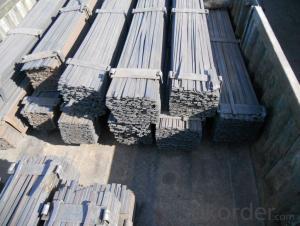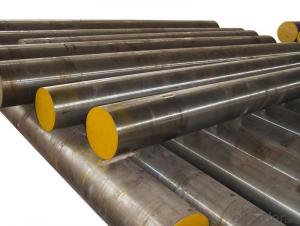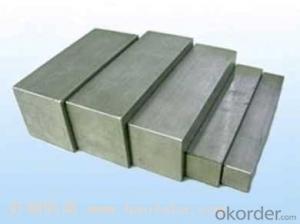High Quality Steel Flat Bar with Grade Q235
- Loading Port:
- Tianjin
- Payment Terms:
- TT OR LC
- Min Order Qty:
- 25 m.t.
- Supply Capability:
- 100000 m.t./month
OKorder Service Pledge
OKorder Financial Service
You Might Also Like
Specification of Steel Flat Bar
Commodity: Carbon Steel Flat Bar
Standard: GB,JIS,ASTM,
Material: Q235,SS400 or Equivalent
Brand name: FLATSPACE
Origin place: China
Thickness: 3mm-30mm
Width:20mm-200mm
Length: Max 12m
Certification: SGS/BV
Chemical composition of Q235
Alloy No | Grade | Element(%) | ||||
C
| Mn
| S
| P
| Si
| ||
Q235
|
B
|
0.12—0.20 |
0.3—0.7 |
≤0.045 |
≤0.045
|
≤0.3
|
Physical properties of Q235
Alloy No | Grade | Yielding strength point(Mpa) | Tensile strength (Mpa) | Elongation after fracture(%) | ||||||
Thickness (mm) | Thickness (mm) | |||||||||
≤16 | >16--40 | >40--60 | >60--100 | ≤16 | >16--40 | >40--60 | >60--100 | |||
≥ | ≥ | |||||||||
Q235 |
B |
235 |
225 |
215 |
205 |
375--500 |
26 |
25 |
24 |
23 |
Above sheets show the technical data of Q235,we can also provide other materials similar to Q235.
Usage/Applications of Steel Flat Bar
Widely used for construction;
Machinery manufacturing;
Iron tower steel structure;
Shipbuilding; Steel grating;
Staircase;
Bridge;
Viaduct;
Railway spare parts;
Boilers making etc.
Packaging & Delivery of Steel Flat Bar
Packaging Details: The Steel Flat Bars are packed in bundles and loaded in 20 feet/40 feet container, or shipped by bulk cargo ,also we can do as customer's requirements.
Delivery Details:30~45 days upon the receipt of buyer payment by T.T. or L/C.
- Q: Can steel flat bars be used for making architectural structures?
- Certainly! Architectural structures can indeed be made using steel flat bars. Steel, known for its durability and strength, is commonly employed in construction due to its ability to withstand different weather conditions and its high tensile strength. Steel flat bars possess the advantage of being easily fabricated and shaped into various sizes, rendering them versatile for diverse architectural designs. They can be utilized for the construction of beams, columns, frames, and other structural components in buildings. Moreover, steel is an environmentally friendly choice as it is sustainable and recyclable. Consequently, steel flat bars find extensive usage in the construction industry and are highly effective for creating architectural structures.
- Q: Cold rolled flat steel standard. What is cold rolled flat steel?
- Section steel is one of the four major steel products (plate, tube, mould, wire). According to the section shape, the section steel is divided into simple section steel and complex section steel (deformed steel). The former refers to the steel, round steel, flat steel, angle steel, six angle steel; the latter refers to the I-beam, channel steel, steel, steel, steel frame bending etc..
- Q: What are the different types of surface defects in brass steel flat bars?
- Brass steel flat bars can have several types of surface defects, which can occur during the manufacturing, processing, or handling of the material. Some common surface defects in brass steel flat bars include: 1. Scratches: These are shallow marks or abrasions on the surface of the flat bar, which can be caused by mishandling, contact with sharp objects, or improper storage. Scratches can affect the appearance of the bar and potentially weaken its structural integrity. 2. Pitting: Pitting refers to small, localized cavities or depressions on the surface of the flat bar. It can occur due to exposure to corrosive environments or chemical reactions. Pitting can compromise the surface smoothness and may lead to further corrosion if left untreated. 3. Rust or corrosion: Brass steel flat bars can develop rust or corrosion when exposed to moisture, humidity, or aggressive chemicals. Rust appears as a reddish-brown coating on the surface and can weaken the bar over time. Corrosion can also lead to pitting or flaking of the surface. 4. Dents or dings: Dents or dings are small deformations or indentations on the surface of the flat bar. These defects can occur during handling or transportation, especially if the bars are not adequately protected. Dents may not impact the structural integrity significantly but can affect the overall appearance. 5. Roll marks: Roll marks are surface imperfections that occur during the rolling process used to shape the brass steel flat bars. These marks can appear as ridges, depressions, or patterns on the surface. While they may not affect the functionality of the bar, they can impact the aesthetic appeal. 6. Scale: Scale refers to the layer of oxides that forms on the surface of brass steel flat bars during heating or high-temperature processes. Scale appears as a thin, flaky coating that can be easily removed by mechanical means. While scale does not affect the structural integrity, it can impact the surface finish. It is important to note that surface defects can vary in severity, and some defects may be acceptable depending on the specific application or industry standards. Regular inspection, proper handling, and appropriate surface treatment methods can help mitigate and prevent these surface defects in brass steel flat bars.
- Q: What is the difference between a steel flat bar and a steel square bar?
- The main difference between a steel flat bar and a steel square bar lies in their shape and dimensions. A steel flat bar, as the name suggests, has a flat rectangular shape with a uniform thickness throughout its length. This makes it suitable for various applications such as supports, braces, and framework. On the other hand, a steel square bar has a square cross-section with equal sides. This shape provides additional strength and stability, making it ideal for applications that require structural support or load-bearing capabilities. Square bars are commonly used in construction, manufacturing, and engineering projects where strength and rigidity are crucial. While both steel flat bars and steel square bars are made of the same material, their shapes and dimensions affect their functionality and areas of application. The choice between the two largely depends on the specific requirements of the project and the intended use of the steel bar.
- Q: Are steel flat bars available in different edge treatments?
- Steel flat bars are indeed available with various edge treatments. Several options for edge treatments on steel flat bars include squared edges, rounded edges, beveled edges, and chamfered edges. These different edge treatments have different purposes and can be chosen based on the specific application or aesthetic preference. For instance, squared edges provide a clean and sharp appearance, while rounded edges offer a smoother and safer finish. Beveled edges are often utilized for decorative purposes or to minimize the risk of sharp corners, and chamfered edges can assist with easier installation or alignment. With the availability of a wide range of edge treatments, steel flat bars can be customized and used in a versatile manner for different projects.
- Q: Can steel flat bars be an alternative to wood in construction?
- Yes, steel flat bars can be a viable alternative to wood in construction. Steel offers several advantages over wood, such as superior strength, durability, and resistance to fire, insects, and rot. Steel flat bars also provide more stability and can support heavier loads compared to wooden beams. Additionally, steel is a sustainable and recyclable material, making it an environmentally friendly choice for construction projects.
- Q: Can steel flat bars be used for tooling or machinery components?
- Yes, steel flat bars can be used for tooling or machinery components. Steel is a strong and durable material that can withstand high loads and provide stability and support. Flat bars can be easily shaped, machined, and welded to create various tooling or machinery components such as brackets, supports, frames, or base plates. Additionally, steel's resistance to rust and corrosion makes it suitable for use in different environments and conditions.
- Q: What are the different methods of finishing the edges of steel flat bars?
- There are multiple ways to finish the edges of steel flat bars, each with their own advantages and applications. 1. By cutting: One of the simplest methods involves cutting the flat bar's edges to the desired length or shape. Various cutting tools, such as shears, saws, or plasma torches, can be used depending on the steel's thickness and hardness. Cutting results in a clean and precise finish, making it suitable for most applications. 2. Through grinding: Grinding the edges of steel flat bars helps achieve a smooth and polished finish. This process entails using a grinding wheel or belt sander to eliminate any rough edges or burrs, resulting in a clean and professional appearance. Grinding is commonly employed for decorative purposes or when a smooth surface is required. 3. By deburring: Deburring involves removing burrs or sharp edges left after cutting or grinding. This can be done manually using a file or deburring tool, or by utilizing a vibratory or tumbling machine. Deburring ensures safety and enhances the overall appearance of the flat bar. 4. Beveling: Beveling refers to creating angled edges on the flat bar. This is often done to improve weldability or create a chamfered edge for aesthetic purposes. Beveling can be accomplished using specialized tools like beveling machines or by hand with a grinder. 5. Galvanizing: Galvanizing involves coating the steel flat bar with a layer of zinc to protect it from corrosion. This method is commonly used when the flat bar will be exposed to harsh environmental conditions or moisture. Galvanizing not only provides a protective coating but also gives the flat bar a shiny and attractive finish. 6. Powder coating: Powder coating is a technique where a dry powder is applied to the steel flat bar and cured under heat to form a protective and decorative layer. This method offers a wide range of colors and finishes, making it ideal for applications where aesthetics are important, such as furniture or architectural elements. 7. Anodizing: Anodizing is primarily used for aluminum, but it can also be applied to steel flat bars to provide corrosion resistance and improve the surface finish. This process involves creating an oxide layer on the steel's surface through an electrochemical reaction. Anodized steel flat bars are commonly utilized in the construction and automotive industries. In summary, the various methods for finishing the edges of steel flat bars include cutting, grinding, deburring, beveling, galvanizing, powder coating, and anodizing. Each method offers unique benefits and is chosen based on the desired functionality, appearance, and durability required for a specific application.
- Q: How do you determine the corrosion resistance of a steel flat bar?
- To determine the corrosion resistance of a steel flat bar, several methods can be employed. One common method is conducting corrosion tests such as salt spray testing or immersion testing. In salt spray testing, the flat bar is exposed to a controlled environment of saltwater mist, simulating corrosive conditions. The bar is then inspected at regular intervals to assess any signs of corrosion or degradation. Immersion testing involves submerging the flat bar in a corrosive solution for a specific period. The solution can vary depending on the intended application, but common examples include acidic solutions like sulfuric acid or alkaline solutions like sodium hydroxide. The flat bar is then examined for any signs of corrosion or changes in appearance. Another method is the use of electrochemical testing techniques, such as potentiodynamic polarization or electrochemical impedance spectroscopy. These techniques involve applying a controlled electrical current to the flat bar and measuring the resulting electrochemical response. By analyzing the data obtained, corrosion resistance parameters such as corrosion potential and corrosion current can be determined. Additionally, it is important to consider the composition and surface treatment of the steel flat bar. Different alloys and surface coatings can significantly impact the corrosion resistance. Factors such as the presence of chromium or other corrosion-resistant elements, as well as the application of protective coatings like galvanization or painting, can enhance the overall corrosion resistance. Overall, a combination of laboratory testing, electrochemical techniques, and consideration of the steel's composition and surface treatment is necessary to accurately determine the corrosion resistance of a steel flat bar.
- Q: Are steel flat bars suitable for making brackets or supports for water treatment systems?
- Yes, steel flat bars are suitable for making brackets or supports for water treatment systems. Steel is known for its strength and durability, making it an ideal choice for supporting heavy equipment and withstanding the harsh conditions of water treatment systems. Additionally, steel flat bars can be easily fabricated and customized to meet specific requirements, ensuring a secure and stable support structure for the water treatment system.
Send your message to us
High Quality Steel Flat Bar with Grade Q235
- Loading Port:
- Tianjin
- Payment Terms:
- TT OR LC
- Min Order Qty:
- 25 m.t.
- Supply Capability:
- 100000 m.t./month
OKorder Service Pledge
OKorder Financial Service
Similar products
Hot products
Hot Searches
Related keywords
